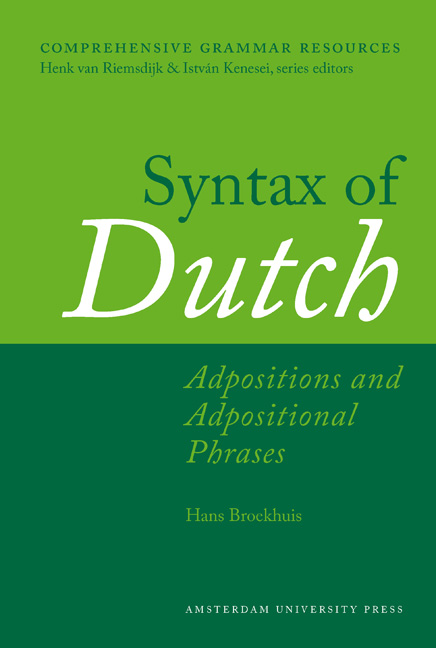Book contents
- Frontmatter
- Contents
- Abbreviations and symbols
- Preface and Acknowledgments
- Introduction
- Chapter 1 Adpositions: Characteristics and Classification
- Chapter 2 Projection of Adpositional Phrases: Complementation
- Chapter 3 Projection of Adpositional Phrases: Modification
- Chapter 4 Syntactic uses of the Adpositional Phrase
- Chapter 5 R-pronominalization and R-words
- Glossary
- Subject Index
- References
- Miscellaneous Endmatter
- Miscellaneous Endmatter
Chapter 1 - Adpositions: Characteristics and Classification
Published online by Cambridge University Press: 10 December 2020
- Frontmatter
- Contents
- Abbreviations and symbols
- Preface and Acknowledgments
- Introduction
- Chapter 1 Adpositions: Characteristics and Classification
- Chapter 2 Projection of Adpositional Phrases: Complementation
- Chapter 3 Projection of Adpositional Phrases: Modification
- Chapter 4 Syntactic uses of the Adpositional Phrase
- Chapter 5 R-pronominalization and R-words
- Glossary
- Subject Index
- References
- Miscellaneous Endmatter
- Miscellaneous Endmatter
Summary
Introduction
This chapter provides a more general discussion of adpositions and their projections (adpositional phrases). Section 1.1 starts by providing a general characterization of the category of adpositions. Section 1.2 and 1.3 continue by discussing two possible ways of classifying the adpositions. The first classification is based on the relative position of the adpositions with respect to their complement (if any), which results in distinguishing the following four subclasses: prepositions, postpositions, circumpositions and intransitive adpositions/particles. The second classification, on the other hand, is based on the meaning of the adpositions, which results in distinguishing the following three subclasses: spatial, temporal and nonspatial/ temporal adpositions. Section 1.4 concludes with a discussion of a number of borderline cases, that is, elements that resemble adpositions in various respects, but for which it is nevertheless not entirely clear whether they should really be considered adpositions.
Characterization of the category adposition
This section provides a brief characterization of the category of adpositions. Section 1.1.1 discusses some characteristic properties of this category. Section 1.1.2 provides illustrations of the four basic types of adpositions: prepositions, postpositions, circumpositions and intransitive adpositions/particles. Section 1.1.3 concludes with a preliminary discussion of the syntactic uses of adpositional phrases. Since the purpose of the discussion below is to provide the necessary background for the remainder of our discussion on adpositional phrases, it is inevitably sketchy and far from complete; most issues mentioned here will be taken up again and discussed more exhaustively later in this study.
Properties of adpositions
There are several features that distinguish the class of adpositions from the other three main categories of words: verbs, nouns and adjectives. These are discussed in Subsection I. It is nevertheless difficult to design syntactic tests that single out the full set of adpositional phrases, although there are several tests that can be used in order to recognize certain syntactic or semantic subtypes. These will be discussed in Subsection II.
Differences from the other main categories of words
The subsections below discuss several respects in which adpositions differ from verbs, nouns and adjectives.
- Type
- Chapter
- Information
- Syntax of DutchAdpositions and Adpositional Phrases, pp. 3 - 166Publisher: Amsterdam University PressPrint publication year: 2013



